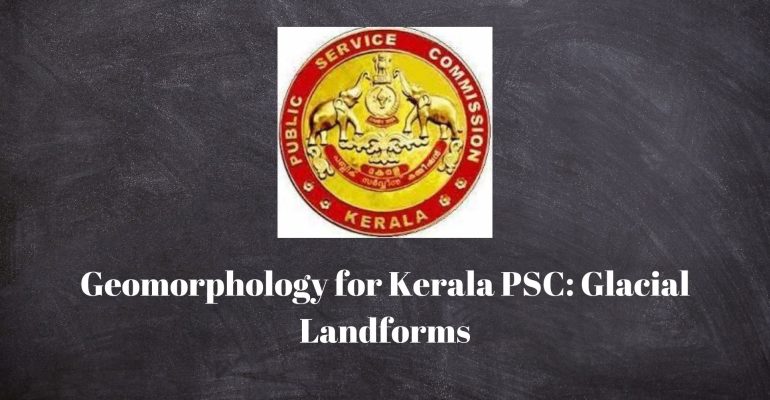Geomorphology for Kerala PSC: Glacial Landforms
June 1, 2022 2022-06-01 19:06Geomorphology for Kerala PSC: Glacial Landforms
GLACIERS
Masses of ice moving as sheets over the land or as linear flows down the slopes of mountains in broad trough-like valleys are called glaciers. Glaciers move basically because of the force of gravity.
Erosion by glaciers is tremendous because of friction caused by sheer weight of the ice.
The material plucked from the land by glaciers get dragged along the floors or sides of the valleys and cause great damage through abrasion and plucking.
As glaciers continue to move, debris gets removed, divides get lowered and eventually the slope is reduced to such an extent that glaciers will stop moving leaving only a mass of low hills and vast outwash plains along with other depositional features.
Erosional landforms of glaciers
Cirque
The cirques quite often are found at the heads of glacial valleys. The accumulated ice cuts these cirques while moving down the mountain tops.
They are deep, long and wide troughs or basins with very steep concave to vertically dropping high walls at its head as well as sides.
A lake of water can be seen quite often within the cirques after the glacier disappears. Such lakes are called cirque or tarn lakes.
Horns and Serrated Ridges
If three or more radiating glaciers cut headward until their cirques meet, high, sharp pointed and steep sided peaks called horns form.
The divides between cirque side walls or head walls get narrow because of progressive erosion and turn into serrated or saw-toothed ridges sometimes referred to as arêtes with very sharp crest and a zig-zag outline.
Glacial Valleys/Troughs
Glaciated valleys are trough-like and U-shaped with broad floors and relatively smooth, and steep sides.
The valleys may contain littered debris or debris shaped as moraines with swampy appearance. There may be lakes gouged out of rocky floor or formed by debris within the valleys.
There can be hanging valleys at an elevation on one or both sides of the main glacial valley.
Fjords
Very deep glacial troughs filled with sea water and making up shorelines are called fjords/fiords.
Depositional Landforms
The unassorted coarse and fine debris dropped by the melting glaciers is called glacial till.
Most of the rock fragments in till are angular to sub-angular in form.
The glacio-fluvial deposits are called outwash deposits. Unlike till deposits, the outwash deposits are roughly stratified and assorted.
Moraines
They are long ridges of deposits of glacial till.
Terminal moraines: They are long ridges of debris deposited at the end of the glaciers.
Lateral moraines: These are form along the sides parallel to the glacial valleys. The lateral moraines may join a terminal moraine forming a horse-shoe shaped ridge.
Ground moraines: Many valley glaciers retreating rapidly leave an irregular sheet of till over their valley floors. Such deposits varying greatly in thickness and in surface topography are called ground moraines.
Medial moraine: The moraine in the centre of the glacial valley flanked by lateral moraines is called medial moraine. They are imperfectly formed as compared to lateral moraines.
Eskers
When glaciers melt in summer, the water accumulate beneath the glacier and flow like streams in a channel beneath the ice. Such streams flow over the ground with ice forming its banks.
Very coarse materials like boulders and blocks along with some minor fractions of rock debris carried into this stream settle in the valley of ice beneath the glacier and after the ice melts can be found as a sinuous ridge called esker.
Outwash Plains
The plains at the foot of the glacial mountains or beyond the limits of continental ice sheets are covered with glacio-fluvial deposits in the form of broad flat alluvial fans which may join to form outwash plains of gravel, silt, sand and clay.
Drumlins
Drumlins are smooth oval shaped ridge-like features composed mainly of glacial till with some masses of gravel and sand.
The long axes of drumlins are parallel to the direction of ice movement.
The end of the drumlins facing the glacier called the stoss end is blunter and steeper than the other end called tail.
The drumlins form due to dumping of rock debris beneath heavily loaded ice through fissures in the glacier.











